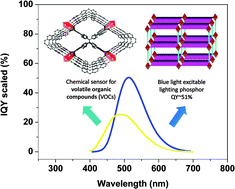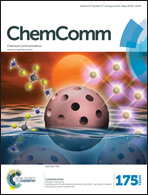Chromophore-immobilized luminescent metal–organic frameworks as potential lighting phosphors and chemical sensors†
Abstract
An organic chromophore H4tcbpe-F was synthesized and immobilized into metal–organic frameworks along with two bipyridine derivatives as co-ligands to generate two strongly luminescent materials [Zn2(tcbpe-F)(4,4′-bpy)·xDMA] (1) and [Zn2(tcbpe-F)(bpee)·xDMA] (2) [4,4′-bpy = 4,4′-bipyridine, bpee = 4,4′-bipyridyl-ethylene, tcbpe-F = 4′,4′′′,4′′′′′,4′′′′′′′-(ethene-1,1,2,2-tetrayl)tetrakis(3-fluoro-[1,1′-biphenyl]-4-carboxylic acid), DMA = N,N-dimethylacetamide]. Compounds 1 and 2 are isoreticular and feature a 2-fold interpenetrated three-dimensional porous structure. Both compounds give green-yellow emission under blue light excitation. Compound 1 has a high internal quantum yield of ∼51% when excited at 455 nm and shows selective luminescence signal change (e.g. emission energy and/or intensity) towards different solvents, including both aromatic and nonaromatic volatile organic species. These properties make it potentially useful as a lighting phosphor and a chemical sensor.



 Please wait while we load your content...
Please wait while we load your content...